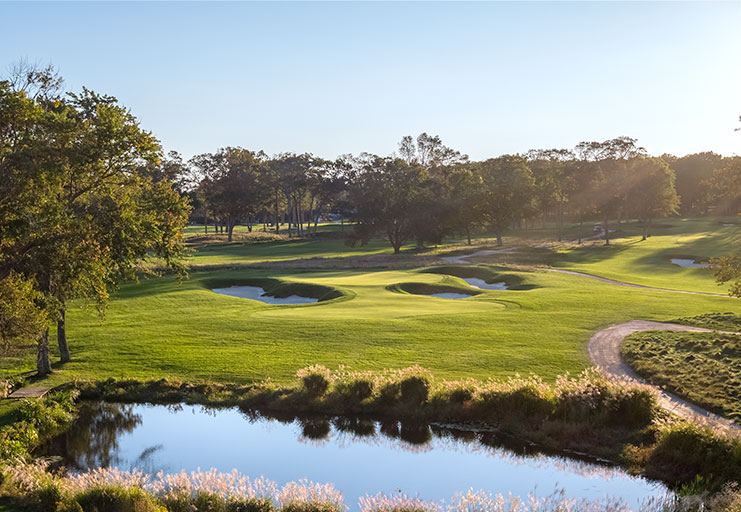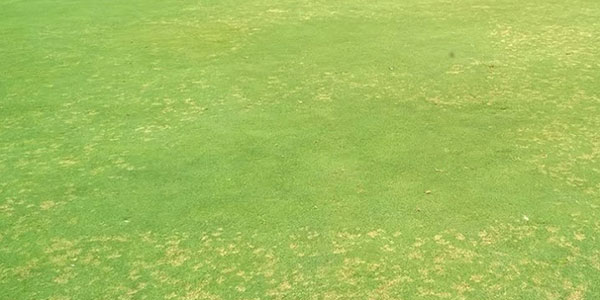______________________________________________________________________________________________________________________________________________________________
The Reviews Are In:
Encartis® Has Quickly Become a Go-To Product for Supers
We checked in with superintendents and BASF agronomy experts in a couple of the nation’s toughest disease regions and heard it loud and clear: Encartis fungicide is a great new tool for fairway dollar spot and a host of other disease issues as a bookend or in-season solution.
By Pat Jones

It was just a few years ago that BASF launched a flurry of innovative new products, including Maxtima® fungicide, Navicon® Intrinsic® brand fungicide and Alucion® 35 WG insecticide. Along with those big new actives, they introduced a fourth new weapon for turf pros: Encartis® fungicide, an enhanced combination product.
Encartis fungicide was designed primarily as a fairway “bookend” spray to be used at the start and finish of the disease cycle most courses go through every year. The concept was simple: Start clean and finish clean, and you’re less likely to have disease breakthroughs or nagging issues that suck up time and budget. The new formulation added a broad-spectrum control to the remarkable effectiveness of a foundational product like Emerald® fungicide.
So now, with a season or two of experience, superintendents are starting to see outcomes from their Encartis fungicide programs. And a surprising number are using it as part of their in-season rotation as well.
We decided to catch up with a few turf pros from a couple of the nastiest disease regions in the nation, the Northeast and Upper Midwest, to find out how the product has performed for them under real-life conditions.
A New Arrow in His Quiver

Curtis D’Anna has been part of The Hartford GC turf team for more than a decade and has been superintendent for the last four years. The Connecticut gem, designed by Donald Ross with an assist from Devereux Emmet, has many of the usual challenges of old clubs, notably too many trees, too much thatch and lots of cultivation needs.
He’s fine-tuning the recently renovated course with detail work: topdressing greens and fairways aggressively, get a better quality of cut and make growth regulators work for him. So he has things going the right direction. Yet one agronomic issue stands out:
“We have tons of dollar spot, particularly on our fairways,” says D’Anna. “We’re always trying to find new things like different products, rotations, nitrogen sources, rates, etc.” He calls himself “a FRAC guy” due to his concerns about resistance.
“I played around with multiple types of SDHIs. I’d used a bunch of them and concluded that nothing was the ‘golden ticket.’ One product wasn’t going to necessarily fix the whole issue. That’s why we try to incorporate different types of chemicals even with the same FRAC code.”
So, he was intrigued when he heard about Encartis fungicide. He had used Emerald fungicide in the past and he liked the idea enough to give it a try. The result?
“We had a really successful year with dollar spot this year,” says D’Anna. “It’s always a combination of factors but we noticed a clear difference. The biggest thing is having something new I know I can lean on. Variety led to success this year in my opinion. Encartis [fungicide] is another arrow in my quiver and I like new arrows.”
He didn’t follow the traditional “bookends” route. Instead, he put a 4-oz/1000 app out on his fairways in mid-June. “Beyond that spray, up until late fall, I was clean.”
D’Anna says he just didn’t need a second Encartis app as a bookend last year but will keep it as an option in future.
Final thoughts? “I’m gonna say it worked! There are a lot of variables in play, but we had the cleanest fairways we’ve seen in a long time.”
Early Adopter in New York

Chris Strong has been succeeding at a very high level at the Country Club of Troy near Albany, N.Y., for two decades. What’s his secret?
“Making sure we put out the best product we can within the parameters we’re given. That’s the main reason I’m still here. I always try to give them a heads up when I see an issue coming.” Examples included anticipating the rise of gray leaf spot and acting quickly to control annual bluegrass weevils after “setting a record for ABW counts” by Dr. Ben McGraw.
So when Encartis fungicide came along, he was once again an early adopter. “My local rep recommended it highly. We usually do our first app – including ABW control – in mid-May when our turf starts to grow. Last year we mixed Encartis in with it that tank and I’ve never had better dollar spot control. I had no dollar spot on my fairways all year. I didn’t change much other than adding it to the mix.”
In 2023, he’s planning mid-May and Labor Day bookend sprays at 3 oz. He likes products with low rates (and is a fan of Maxtima). “There are a few higher-rate products you just have to have but I really prefer the ones with low rates and FRAC codes that fit my program. I try not to spray anything more than twice. Most are one-shot products.”
After that first Encartis fungicide app last spring, he was shocked that, by the beginning of July, he hadn’t seen dollar spot anywhere. And the success continued after he made the second app in the fall. “We usually get severe pressure in the fall, and I used it right after Labor Day and I never had to spray again. It took me right through to snow mold.”
He also noticed an improvement in fairway turf quality. “My turf density was outstanding. It’s usually good but it was standing straight up and super healthy.”
He’s sold on the Encartis bookend approach moving forward: “It was perfect for us and I hope we get that same kind of control as long as possible.”
The Math Makes Sense in Chicago

Craig Kight has worked around the country for several management companies, but for the past eight years, he has awakened daily to care for Eagle Brook CC, which sits 45 miles west of Chicago in Geneva, Illinois. It’s a community club brimming with fun events, families and kids, but that’s not the only site he’s thinking about: He serves as a regional superintendent for Arcis Golf and works with superintendents at six other facilities in the region.
Eagle Brook is a big property, nearly 500 total acres, and the golf course has 40 acres of mostly bentgrass. “Our challenge starts with Illinois soils that don’t drain well, so fighting anthracnose and dollar spot on our fairways has been the number-one issue. It’s been a battle with those two active fungi,” he says.
One important goal was to getting the job done and minimizing labor demands and inconveniences for members. “Based on that, we decided to try Encartis [fungicide]. We were due to spray [on] Labor Day — this was 31 days after a Maxtima [fungicide] app — but we were in the middle of a bunch of stuff. I was tired, and storms were coming, [so I] decided to let it ride and push the Maxtima [fungicide] way past normal limits. Predictably, we lit up with dollar spot over the weekend. We had active dollar spot on 65% of fairways and our tee boxes.”
He decided it was now or never for the new product. “We put the Encartis [fungicide] out that day. By Thursday, I had zero pitting and zero disease activity. I didn’t spray fairways again until our snow mold app in December. I couldn’t believe it.”
Kight was astonished. “Normally have two to three apps after Labor Day through snow mold. It was unbelievable — it just shut it down. We had perfect dollar spot weather the rest of the season and didn’t see anything.”
This year, all of the clubs he oversees in the Chicago area are scheduled for a spring/fall Encartis fungicide program. “I’m looking forward to taking this mindset into those other clubs. We all just used tebuconazole previously, but after seeing the Encartis [fungicide] results, we all rethought our strategy.”
The math also makes sense for Kight. “I figure it’s always been about $2,000 per app, not counting labor, for those generic fairway apps. If I’m now saving $5,000-$8,000 in spring and fall, that’s pretty big. [When I look] at rates and costs, there is zero reason to use generics for this, in my opinion.”
The other thing that helps the financial side is early order. “When I started here, I was spending close to $75,000 annually on fungicides and using a lot of generics. Now, with agency products purchased through EOP, the rebates actually make it cheaper than my generic program was eight years ago. So, in my opinion, generics really don’t save us money.”
No Worries at Spring Lake

Tad Miller’s life got simpler in 2013 when he was able to regrass Spring Lake CC with V8 bent and Crystal BlueLinks bent on fairways. “It’s a lot better managing a newer bent than Poa,” he says. But nothing is perfect, and he soon discovered that he had to be very aware of brown patch in his steamy part of Illinois near the Mississippi River. “That’s why when Navicon [Intrinsic brand fungicide] and Maxtima [fungicide] came along, we started using them religiously. I’m a BASF believer.”
So, when Encartis fungicide arrived, Miller was intrigued, but he also saw an opportunity to use it in-season on his greens instead of primarily just as a fairway product applied early and late. His basic greens program now is Honor Intrinsic brand fungicide in April, Navicon Intrinsic brand fungicide in early May, Lexicon® Intrinsic brand fungicide around Memorial Day and then Encartis fungicide in June at 3.5 oz/1,000 to knock out the brown patch. “We get pretty hot here, but with that program, you have no worries,” he says.
From that point, Miller will go with Xzemplar® fungicide in mid-July and a final Lexicon Intrinsic brand fungicide app around August 1. Then he’ll do a second Encartis fungicide app in August. “I’m always trying to change chemistry,” says Miller.
“I know they talk about it at the beginning and end of the season, but I like using it in the middle of the season here.” He’ll finish strong with Navicon Intrinsic brand fungicide and Xzemplar fungicide in September and Maxtima fungicide in early October, but he won’t be done with Encartis fungicide on his greens — he plans to use it as his snow mold app the first week of December.

For Miller, the bottom line for Encartis fungicide is effectiveness. “It isn’t that much more [expensive] than mixing it yourself. I’d usually get some breakthrough when I mixed it myself. The Encartis [fungicide] works, and we didn’t get any breakthrough.”
On fairways and green banks, Miller is fighting soil-borne diseases, so the strategy is a little different. “I do Maxtima [fungicide] in April and May, then, in June, I will use the Encartis [fungicide] again.” He’ll use a chlorothalonil-based spray after that, then return to Encartis fungicide at [the] end of July. “I’m spraying Encartis [fungicide] more in the heat because of how well it fights the brown patch.”
How’s it working for him? “I had my best year last year with Encartis [fungicide] in the mix. It was a tough summer for most people, but since I’ve gone to this program, we’ve stayed clean. I know it won’t let me down, so I build my program around those key BASF products.
What stands out most for Miller? “I don’t have to worry about the brown patch creeping up on me. And the price isn’t that bad either. It’s so much easier because it’s a premix. It just comes right out of the jug, ready to go. It mixes well with other things too.”
For Miller, the bottom line for Encartis fungicide is effectiveness. “It isn’t that much more [expensive] than mixing it yourself. I’d usually get some breakthrough when I mixed it myself. The Encartis [fungicide] works, and we didn’t get any breakthrough.”
Always read and follow label directions.
Alucion, Encartis, Lexicon, Maxtima, Navicon and Xzemplar are registered trademarks of BASF.


